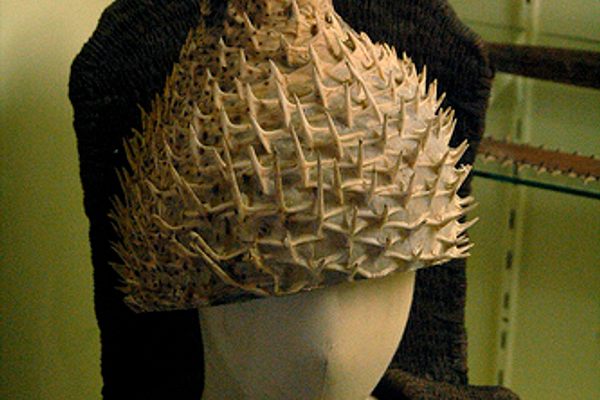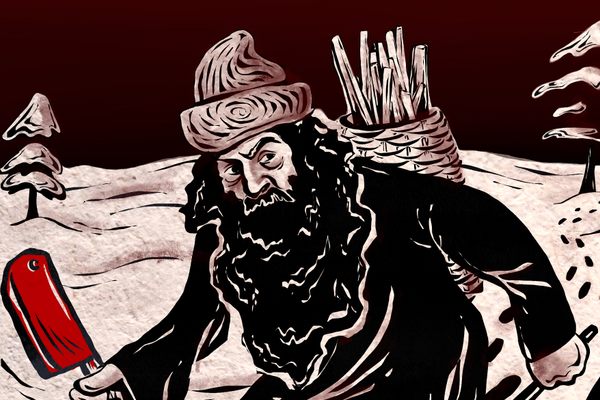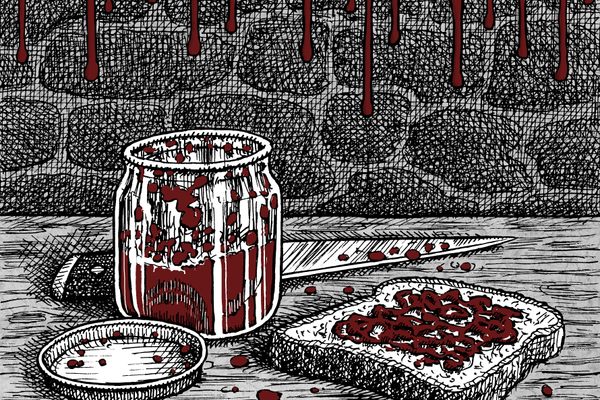Morbid Monday: Meat is Murder - The Fiji Cannibal Fork
Our mysterious artifact, photographed by Robert A Bachmann in 1917 (via National Geographic)
BBQ season is peaking, with parks and gardens mushroomed with grilled meat festivities. But because it’s Morbid Monday, we won’t explore the new wave in burger gastronomy, although we will discuss the art of cooking…
Can you guess what the below instrument is?
(via Tribal Mania)
Here are a few clues: its vernacular name is “Ai Cula Ni Bokola”; it was carved out of red wood in 19th century; and it originates from the Fiji Islands… Any Ideas ?
Well, it’s a fork. Although, behind this fine piece of cutlery is the ultimate taboo. Ai Cula Ni Bokola are commonly called “Cannibal Forks.”
Let’s go back in time a bit. Discovered around 1640 by Dutch explorer Abel Tasman, and visited by Captain Cook in 1799, the Fiji Islands became a permanent settlement for European missionaries and whalers during the early 19th century. But the customs of the native tribes freaked out our intrepid occidental travelers when they realized that Fijians were actively snacking on each other. Soon, the Fiji Islands became known back in Europe as the infamous “Cannibal Isles,” while billions of legends and horrific tales were brought back to the Old Continent. However, some explorers also tried to render as objectively as possible the realities of the Fiji tribes through their reports, and soon with photographs. Decades after decades, anthropologists and archaeologists gathered evidence to decipher the function of Fiji cannibalism.
One of the first discoveries was that Fiji natives were actually great fishermen and had developed agriculture — they didn’t eat human flesh because of dietary distress. But as a matter of fact, territorial belonging might have been a problem itself, since the territory was limited in space. As Asesela Ravuvua, a Fijian academic, described it :
The land is the physical or geographical entity of the people, upon which their survival […] as a group depends. Land is thus an extension of the self. Likewise the people are an extension of the land. Land becomes lifeless and useless without the people, and likewise the people are helpless and insecure without land to thrive upon.
Fiji tribes were in constant warfare, for lands and life on the islands were patterned by violent conflicts between indigenous groups. Most of the utensils we now associate with the fearless Fijians are the impressive wooden clubs of the warrior regalia. Heavy, sometimes spiky, they would knock out and kill any enemy in one hit.
“Figi” Cannibals imported by Barnum in 1872-73 (via Sideshow World)
And it’s at this point of the story that the cannibalism ritual should be introduced. Fijians were not actually feasting on their own members, it was “exophagous,” which means the human they would consume the flesh of didn’t belong from their community. The dreaded enemies of other tribes were the main courses. Eating your nemesis was in fact was purely motivated by revenge, a public humiliation ritual which became, for centuries, one of the strongest cultural norms of the territory.
Once bitten to death, the victim of the assault was dismembered and cooked on a fire pit and then distributed to the members of the tribe. But the Fijians had their own sets of values and, if eating human flesh was not prohibited and morally wrong, other behaviors or actions were restricted. The head of the community, chiefs, and priests, were considered too holy to touch food. For this reason, attendants to the ceremony had to feed them with those precious wooden forks with which they would pick the roasted flesh. Considered one of the most sacred relics of each tribe, these forks were kept in the Spirit House and were only used during cannibal ceremonies. If these practices stopped during the second part of the 19th century when missionaries converted the natives to Christianity, some stories still seem very vivid.
The most famous one surrounds a 19th century “Ratu” (Chief) named Udre Udre, one of the last cannibals of northern Viti Levu. Udre Udre allegedly kept a stone for every enemy he tasted the flesh of, a number that oscillates according to the sources between 827 and 999, which makes him the most prolific cannibal ever documented. These stones are nowadays still surrounding his grave, in the town of Rakiraki.
Udre Udre’s Tomb in Rakiraki - Photo By Josh Krancer (via pbase)
Cannibal forks are now rare and collectible items, tracked by exotica collectors and once in a while sold by antique dealers as ethnographic curiosities. Of course the historical Fiji Museum owns several of them, but you won’t have to go so far to actually admire genuine ones since the Penn Museum of Archeology and Anthropology, the Burke Museum, and the National Museum of Ireland have some specimens in their collection. And for those of you who want to impress your friends with a great and (fake) explorer story, you can often buy replicas on eBay, and maybe use them to turn the steaks on your own grill!
CANNIBAL LORE:
UDRE UDRE’S GRAVE, Viti Levu, Fiji
FIJI MUSEUM, Suva, Fiji
Morbid Mondays highlight macabre stories from around the world and through time, indulging in our morbid curiosity for stories from history’s darkest corners. Read more Morbid Mondays>
Join us on Twitter and follow our #morbidmonday hashtag, for new odd and macabre themes: Atlas Obscura on Twitter











Follow us on Twitter to get the latest on the world's hidden wonders.
Like us on Facebook to get the latest on the world's hidden wonders.
Follow us on Twitter Like us on Facebook